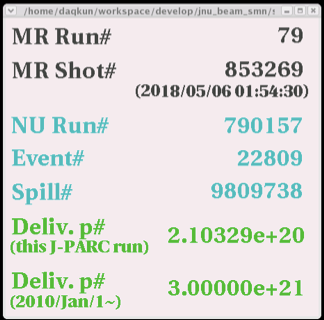On May 5, 2018, the number of protons delivered to the neutrino target of the T2K experiment by the J-PARC accelerator reached an important milestone: 3×10^21 accumulated since January 2010. Many thanks and congratulations to the J-PARC accelerator teams for their outstanding work to make this possible !

The protons are produced by the J-PARC Main Ring synchrotron accelerator in Tokai on the east coast of Japan. The 30 GeV protons are directed onto a graphite target, producing charged pions and other secondary particles. These pions pass through three magnetic “horns,” which are able to preferentially focus either positively-charged or negatively-charged pions in the direction of T2K’s neutrino detectors. Positively charged pions quickly decay to produce muon neutrinos , while negatively charged pions decay to produce muon antineutrinos. This allows T2K to produce a beam composed mostly of muon neutrinos or muon antineutrinos by changing the direction of the magnetic horn current.
The number of protons delivered by the accelerator to the neutrino generating target is called “Protons on Target (POT)”, which is the typical performance indicator for the data volume of accelerator-based neutrino experiments, like T2K. For discoveries of new physics in the neutrino sector, we are aiming to maximise the accumulation of POT.
T2K is operating stably with an average beam power of about 495 kW in 2018.


